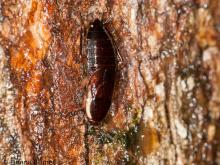Land Invertebrates
Media

Species Types
Scientific Name
Myzinum quinquecinctum
Description
Female and male five-banded thynnid wasps look quite different. Both are banded with black and yellow, but the females are large and heavy-looking, while the males, often seen in groups, are much skinnier and have a scythe-shaped false stinger on the hind end.
Media

Species Types
Scientific Name
Apis mellifera
Description
The honeybee is a major pollinator of many field crops and tree fruits. Native to the Old World, it is not native to North America. In 1985 it was named the official state insect of Missouri.
Media

Species Types
Scientific Name
Over 100 species of cockroaches and termites in North America north of Mexico
Description
Cockroaches well-known: they are flattened, small, brown or black, often shiny insects that can hide in tight crevices and lack specialized appendages. Recently, termites have been included in their order.
See Also



Media

Species Types
Scientific Name
Cisseps fulvicollis
Description
The yellow-collared scape moth is more often “orange-collared.” And whether you think it looks more like a firefly or a wasp, it’s still a moth!
Media

Species Types
Scientific Name
Nearly 150 species in North America north of Mexico
Description
Slim, delicate plume moths are instantly recognizable by their T-shaped silhouette, long legs, and muted shades of tan and brown. It can be hard to separate the various species.
Media

Species Types
Scientific Name
Pyrrharctia isabella
Description
Not many people know the adult Isabella tiger moth when they see one, but we’re all acquainted with its caterpillar, the woolly worm, or woolly bear.
About Land Invertebrates in Missouri
Invertebrates are animals without backbones, including earthworms, slugs, snails, and arthropods. Arthropods—invertebrates with “jointed legs” — are a group of invertebrates that includes crayfish, shrimp, millipedes, centipedes, mites, spiders, and insects. There may be as many as 10 million species of insects alive on earth today, and they probably constitute more than 90 percent all animal species.





















